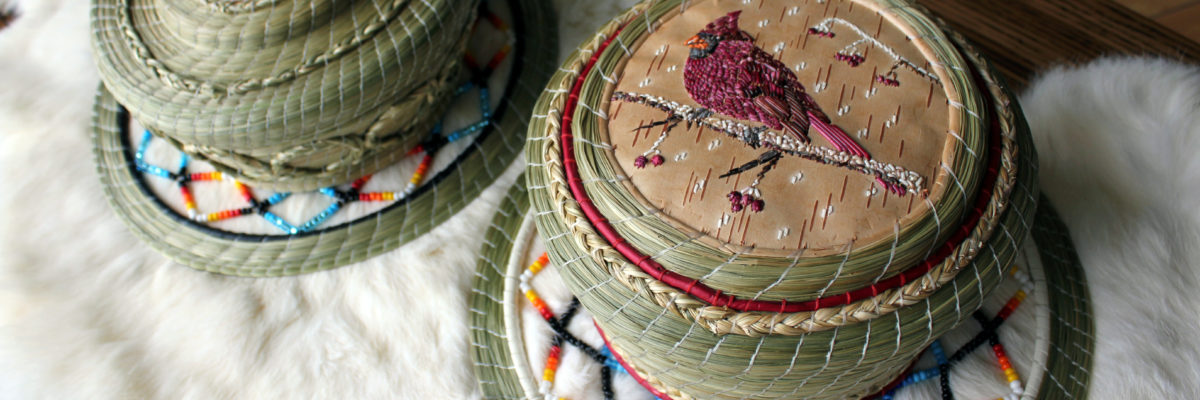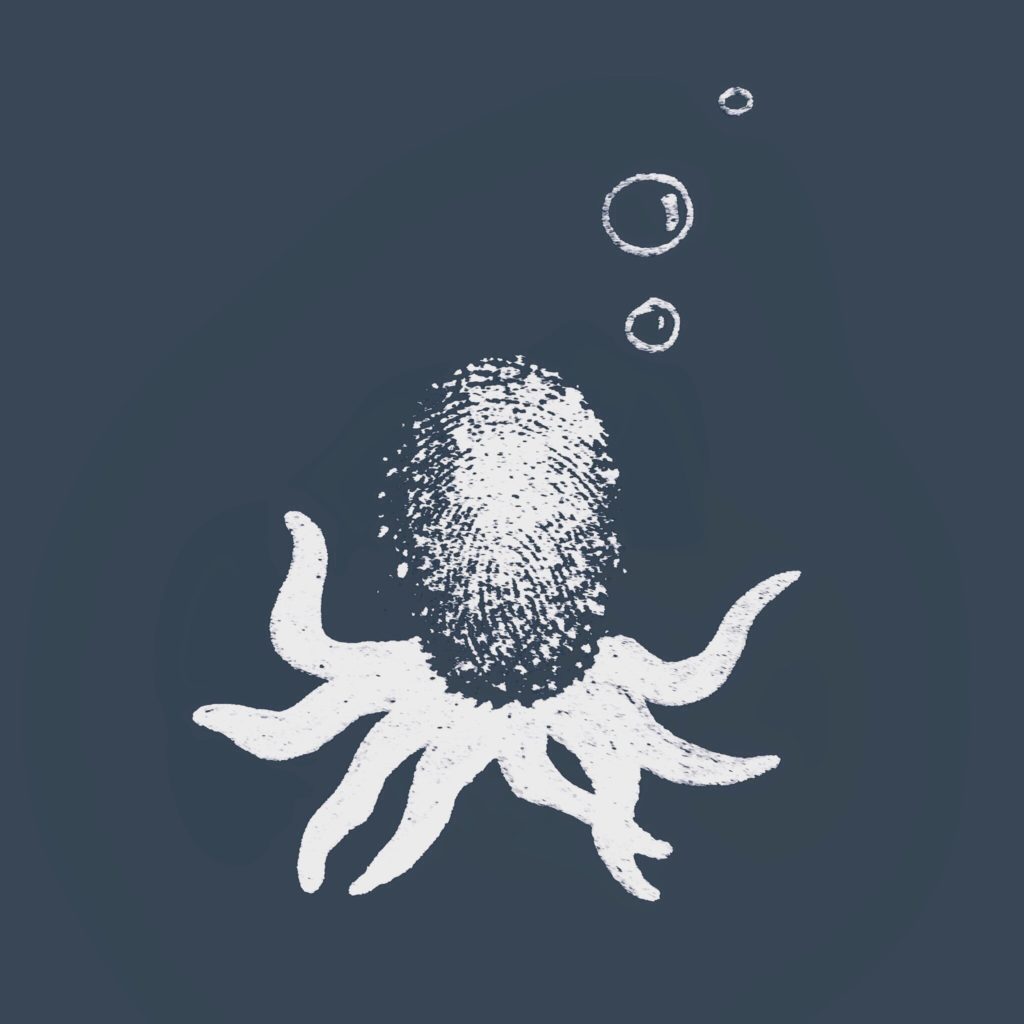Burlington Tooshkenig Brings Rare Indigenous Art Form to Newfoundland and Labrador
September 2019
Between the Great Lakes Huron and Eerie lies a small body of water called Lake St Clair. Detroit sits at the lake’s southwest corner, but its opposite end, across the Canadian border, is the very antithesis of a concrete jungle.
Here, the St Clair River forms a delta where it empties into the lake, carving the land into five islands. Known as Bkejwanong, Ojibwe for where the waters divide, these islands are unceded First Nations territory and home to Ojibwe, Potawatomi, and Odawa peoples. The river waters fill the area with rich sediment, supporting a diverse ecosystem with flora and fauna that can be found nowhere else in Canada.
Burlington Tooshkenig now makes his home in Carbonear with his wife and two children, but this idyllic landscape is where he was born and raised. It’s also where he was first introduced to the traditional art of sweetgrass sewing.
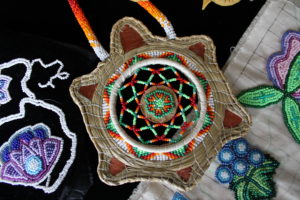
Turtle medallion made using sewn sweetgrass, birch bark, and beads.
“I was about four or five years old. My first recollection was sitting at my grandmother’s feet watching her sew baskets, make afghans, and fix quilts. As she was doing it, she would tell me what she was doing, and she would show me.
“She never spoke to me in English. She only spoke to me in Ojibwe, which was our native tongue, and that’s where I learned it.”
Sweetgrass – wiingushk in Ojibwe – is a fragrant herb that grows wild across northern Eurasia and North America. It’s considered a sacred medicine by many North American Indigenous cultures and is widely used in ceremonies, for smudging, and as an herbal remedy.
In most places sweetgrass reaches a height of only two and a half feet, but in the fertile soil of Bkejwanong Territory it can stretch up to ten feet tall. Since the plant grows so well and so abundantly in the region, local Indigenous peoples came to use it in their basketry. Instead of weaving the sweetgrass leaves in a mesh, however, they stitched them together in coils.
As much as Tooshkenig enjoyed watching his grandmother sew sweetgrass as a child, he wasn’t inspired to take up the art himself until he was a young adult. By then, his grandmother had passed away, and there were only five sweetgrass-stitchers left in his community of 2,000.
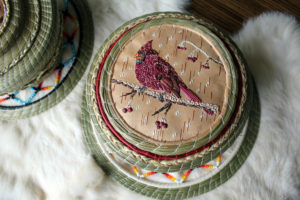
Detail of a cardinal rendered in dyed porcupine quills on birch bark.
“There was a generation – which was probably my generation – that just didn’t take interest in traditional arts or language, things of that sort,” he explains. “So a lot of it almost completely died out.”
Tooshkenig began experimenting with basket-making using what he could recall of his grandmother’s teachings.
The process is time-consuming and exacting. The sweetgrass must be manipulated by hand to shape the basket and then held in place while stitching. At the same time, additional strands need to be gradually added to the bunch to keep the thickness of the coil consistent throughout.
“My first few baskets were kind of wobbly, as you can imagine!” he laughs.
A neighbour who had learned how to sew sweetgrass from her mother helped him refine his technique. Today he creates finely worked baskets with elegantly curved surfaces, which he sells through his business Sweetgrass & Cinnamon.
Tooshkenig stitches using pre-waxed imitation sinew or four strands of cotton thread, bindings strong enough to hold the bunched sweetgrass in place. His finger is calloused from pulling the sinew taut.
Even so, he says, this modern method is easier than the traditional process of punching holes in the sweetgrass with a homemade awl and threading them with strips of basswood.
“It was very arduous. It was two or three steps for each stitch.”
Sewn sweetgrass baskets look distinctively different from woven baskets. Their sides are more or less smooth except for the ripple effect created by the lines of stitches, and they can be embellished in a variety of ways. Tooshkenig’s baskets are decorated with sweetgrass braids, dyed spruce root, and birch bark.
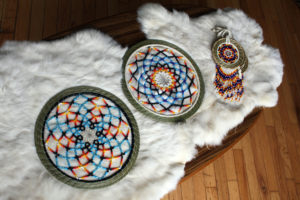
A selection of Tooshkenig’s dreamcatchers.
Many of the natural materials he uses in his work were harvested here in the province. Although sweetgrass does grow wild in Newfoundland, it’s difficult to find, so he generally orders that element in from other communities, and he’s just started growing it himself.
A self-taught practitioner of many Indigenous art forms, Tooshkenig beads, makes moccasins, and creates dreamcatchers in addition to sewing sweetgrass, and he blends these practices together to create his original works. His beaded dreamcatchers feature stitched sweetgrass rims – his own innovation – and he’s recently begun to incorporate quillwork into his basket lids.
Practised across North America from the sixth century CE onward, quillwork is the art of embedding porcupine quills into fabric to create decorative motifs.
“Long before there were beads in North America,” Tooshkenig tells me, “quills were used as adornment for what we would call regalia today. It was actually just your ‘Sunday best’ – the outfits that people would use to go to special meetings or ceremony.”
He shows me a large Tupperware container filled to the brim with quills. I touch them gently. Each black-tipped needle is about three inches long. Proving there’s nothing you can’t buy on the internet, this supply of quills comes from a whole porcupine he ordered off eBay.
Before using them in his work, Tooshkenig dyes the quills an array of colours. He then inlays them into birch bark, creating stylized florals and delicately feathered songbirds.
He draws inspiration partly from his large collection of Indigenous art. Shelves in his living room hold a multitude of baskets and moccasins, some more than a century old.
Keeping an eye out for estate sales and online listings, Tooshkenig has saved more than one beautiful piece from being thrown in the trash, and he uses his skills to restore artworks that have deteriorated over time. He’s currently rejuvenating a birch bark basket from the 1940s by repairing its quillwork designs and sewing fresh sweetgrass around its edges.
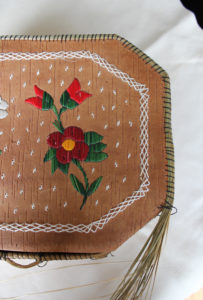
Basket restoration in progress. The basket and its floral quillwork are original to the 1940s. Tooshkenig has refurbished the decorative white quill border and is sewing fresh sweetgrass around the edges of the lid.
Still, he doesn’t treat his collection like a museum display. Instead, he and his family wear the antique moccasins on special occasions. If the soles eventually wear out, he’ll replace them with fresh hide, preserving the beaded uppers – a customary method for refurbishing moccasins.
Why keep them in use, rather than preserve them in pristine condition?
Because, he says, “There’s nothing sadder than an unopened gift.”
While it’s part of a rich history, Tooshkenig’s own art is likewise vital and modern. By innovating within tradition, he demonstrates that sweetgrass sewing is a vibrant, living art form, equal parts cultural heritage and individual expression.
Ainsley Hawthorn, PhD, is a cultural historian, author, and artist who lives in St John’s. She is currently finishing her first book, The Other Five Senses.

